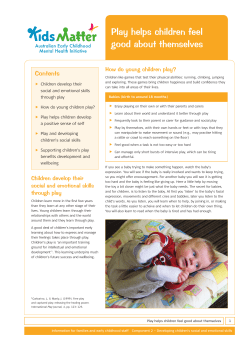
0 – 24 months 2 – 3 years 3 – 4 years
Age Beginner’s Guide to Children’s Drawings and Development The Gallery commissioned educator Wanda Stanleyto respond to Lowenfeld’s classification system and redress the balance by exploring more widely how children learn about their world and become creative participants in society and culture. This guide has been illustrated with drawings by pupils from Abbey Hey Primary School, Gorton. Purely for stylistic reasons and not gender bias, we have used the term ‘he/his’ throughout to refer to the child. 2 – 3 years Scribbling Stage The child enjoys the motions of scribbling as a kinaesthetic activity. Viktor Lowenfeld He is not trying to represent or portray objects. Instead the only source of the scribble is the child himself. 3 – 4 years NAMING scribbles starts when he connects his marks and motions to the world around him. He shifts away from kinaesthetic experience to imaginative activity. At this point, he often wishes to start using different colours. 4 – 7 years Pre-schematic Stage Children draw what they know. Child begins his first representational attempts. Scribbles start to become recognisable both to the child and adult. Usually, the first drawing of this kind is a person, typically drawn with circle for head and two vertical lines for legs or body. The shift from DISORDERED to CONTROLLED scribbling occurs when the child discovers the connection between the marks on the paper and his own movements. There is a relationship between the child’s mental and drawn pictures. This translation is called a concept. There is a constant searching for new concepts and how he represents a person today may be different from tomorrow. This stage causes a sense of satisfaction as he achieves greater representation of the world. Wanda Stanley Viktor Lowenfeld , an Austrian professor who was once a pupil of Franz Cizek, wrote one of the most influential textbooks on art education in 1947. In Creative and Mental Growth, he developed a system for classifying children’s drawings according to the stages in their chronological development. 0 – 24 months Sensory Development Empathy and Expression Imagination Key Stage 1 The child explores the world through all the senses: hearing, touch, smell, taste and sight. He communicates with his whole body and makes a range of sounds including rhythmical babbling and trying to imitate words.Through exploratory activities he creates a perceptual framework of his world. Exploration and play are one and the same in his physical, mental and emotional development. Exploration now includes egocentric speech. Increasingly he imitates adults, ‘pretends’ and ‘becomes’ a person or object. There is a strong imaginative urge, he makes up people, stories and events and believes they are real. He makes objects and events his own through image or action. He draws and paints ‘what he knows’ rather than what he sees; the proportion and size of objects and people is related to personal hierarchy of importance not mathematical or visual accuracy. Exploring through Play He begins to try to comprehend his own feelings and those of others. He begins to experiment with different methods of communicating his feelings and repeats successful strategies. He challenges authority and begins to manipulate the situation according to adult response. He seeks the company of peers. He learns about ‘enlightened self interest’ and tries to ‘please’ to gain his own ends. He discovers the quality of empathy. Given a rich, encouraging and ever expanding environment the child continues to explore his world through play. Movements are more controlled. He moves, dances, draws, paints, sings, mixes babbles with words, uses inflection, holds conversations, uses his world as his play material. He lives expressively. He is creative. He delights in music and begins to sing and uses objects to make a variety of sounds. He begins to label objects and actions; says simple sentences; makes up rhymes. He begins to use tools that he treats as an extension of himself; makes marks, draws and paints. He is developing motor and manipulative skills. His expressive acts reflect this development. He lives creatively. He begins to build verbal hypotheses: the ‘what if’ and ‘why’ stage and explores the relationship of the past to the present and to the future. He is anxious to extend his vocabulary and often makes up words. He becomes frustrated and angry at the disbelief of adults as they challenge ‘his’ truth. He can talk about feelings, becomes increasingly sensitive and relates his own experiences to those of others. He does not differentiate between value and moral judgements. His expressive acts are imaginative and full of fantasy. He engages freely and joyfully in expressive acts. Age Viktor Lowenfeld 7 – 9 years 11 – 14 years 15 – 16 years The Schematic Stage The Gang Age Stage of Reasoning The Period of Decision Children draw what they see Dawning Realism Pseudo-naturalistic Stage. A schema (symbol of a real object) is repeated again and again. It confines itself to the object, “this is a tree”, and is the concept at which the child has finally arrived. Group cooperation and growing social independence characterise this stage. One of the most challenging and exciting stages. This is a period of transition from childhood to adulthood. Psychological changes respond directly to biological changes and the development of his creative thinking. The child’s world of imagination shifts to a more critical awareness of the self. The child develops a greater awareness of self and how and why things are as they are. The schema is now insufficient to express objects and figures. He focuses on those details he perceives as emotionally significant. Since girls tend to develop (physically) earlier than boys, they are usually more interested in drawing the human figure than boys. Often, the sexual characteristics of these figures are prominent or exaggerated, reflecting their anxieties over their own physical development. He becomes very aware of the relationship between colour and object. The child develops a greater visual awareness. The single baseline begins to disappear and he becomes conscious of objects overlapping and the relationship between them. Other children respond well to visual stimuli, rather than focusing on interpreting their subjective experiences. They are much more interested in light, colour, tone, shadows and perspective. The haptic(feels and experiences, ie: draws human figures as interpreters of emotions and feelings). Key Stage 2 Key Stage 2 Key Stage 3 Key Stage 4 A seeking for realism and truth emerges. His expressive outcomes often reflect a range of feelings about the subject; they can have a therapeutic value. The adolescent is frightened both academically and emotionally. He relinquishes and apparently despises the world of childhood and begins to feel safer ‘talking about things’ than ‘doing things’. Timidity can give way to an apparent increase in self-esteem, sometimes bordering on arrogance. He wants to be accepted as an adult and respected, to be taught rather than discover but he does not accept advice easily. At this stage, awareness of perspective has not yet been developed. The child draws a base line. He is conscious of the relationship between himself and environment. He usually places everything on the baseline. He seeks to acquire, develop and perfect motor and manipulative skills. Wanda Stanley 9 – 11 years There is a growing awareness of ‘adult’ arts. There is an increasing frustration with his inability to make things ‘look real’. He is eager to learn new words and enjoys using written and spoken language in an increasingly adult way. Pre-adolescent confidence gives way to adolescent anxiety and loss of confidence and self-esteem. He needs much praise. He likes working in groups for safety but at the same time is often unable to cooperate. He responds to ‘new’ materials and being presented with original problems requiring divergent thinking in arriving at innovative solutions which have no, or very few referents for them and have no ‘right or wrong’ answers. He likes things that ‘look tidy and work’ and looks forward to vocational outcomes, ie. creative thinking with objective outcomes. At this stage the arts are vital. He covertly responds to positive enforcement and praise which is often, publicly rejected. Two creative types begin to emerge at this stage; The visual (sees and observes, ie: draws human figures of correct size, features and proportions) Through appropriate activities he is now beginning to be motivated both personally and vocationally. He becomes politically and socially aware and often rejects ‘the system’. An emergent, personal, social, cultural and political philosophy gives rise to expressive acts. Through the arts the young adult can be helped to explore his gender identity, develop personal and social skills and grow in confidence and maturity. e d i u G s s g ’ r n i e n w n a i r Beghildren’s D ent to Cnd Developm a
© Copyright 2025





















